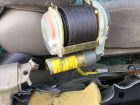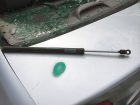
Extrication tips: What can we cut?
By Chad Roberts
Features Auto Extrication Chad Roberts Air bag inflation cylinder: Try to avoid cutting, but if absolutely necessary do so with a Sawzall and not a hydraulic cutter.
Photo : Chad Roberts
Air bag inflation cylinder: Try to avoid cutting, but if absolutely necessary do so with a Sawzall and not a hydraulic cutter.
Photo : Chad Roberts After recently doing some training with our auto ex team and shortly thereafter with my crew, I realized we had many different questions related to the scenarios and vehicles that were put in front of us. Why can’t I cut this? And how come I can cut it with this, but not that? I’m going to try and answer these and other typical questions related to cutting.
Before we get into why we can or can’t cut something, let’s talk about what we can use to cut. From manual tools, such as cable cutters and snips, to more extreme levels of power such as the Sawzall or hydraulic cutter, we must remember that we have many options in the box when it comes to cutting. Carefully choosing the right tool for a specific cutting application can be the difference between saving time and making things a lot worse. Over the rest of this article I’m going to address whether the following can be cut and if so, how we can safely do it: high voltage cables, seat belt pretensioners, airbag inflation cylinders, and gas hood/tailgate struts.
High voltage cabling is a fairly safe and easy place to start when it comes to cutting. These cables are generally labelled very clearly by their orange colouring. They usually run the length of the vehicle on the underside, either directly up the middle or sometimes off to one side. When it comes to cutting high voltage cables, the answer is a hard NO. With varying high voltage ratings up to 600 volts in some components, cutting these should always be avoided, even when the power is cut. The only exception in this case would be the “cut loop”. This is very common in all Tesla models and is becoming more apparent in other hybrid/electric vehicles. While being colour coded in orange as well, this loop is clearly marked as a cut point to kill the power to the vehicle’s high voltage system.
Now let’s move on to something a little more misunderstood: seat belt pretensioners. To fully understand whether or not these can be cut, we must differentiate between the seat belt “tensioner” and the “pretensioner”. The tensioner is the physical part that houses the belt and when triggered, tightens the seat belt on impact. The pretensioner is the explosive charge that triggers the tensioner to do the job as previously mentioned. The locations of these in most vehicles we will see on the road today are in the upper or lower B post, or may be located at the buckle end of the restraint system by the base of the seat. The pretensioner is the part that should be completely avoided. The pretensioner is generally attached to the side or in very close proximity to the tensioner, and may even be easily identified as the piece with a wire running out from it (See picture). Expose and identify carefully before cutting.
When talking about airbag inflation cylinders, we have to be more careful choosing the correct tool. The airbag inflation cylinder can be located closely to each airbag, or sometimes wrapped in the airbag (see top picture). These cylinders house the charge that will fill the airbag. Exposing and identifying these cylinders is critical before making cuts. As with any hazards in the vehicle, it is always best practice to simply avoid them. However, what if we are faced with no other option in a tight space and a limited amount of time? This is where tool selection becomes imperative. By choosing the hydraulic cutters for this specific job, we run the risk of triggering an explosion. Just imagine squeezing a full can of pop until it finally bursts and you get an idea of what an airbag inflation cylinder might do when cut with hydraulic cutters. Selecting the Sawzall will prove more effective and safer when cutting the cylinder. By cutting with the blade of the Sawzall, the hole created by the blade will help slowly release this gas. We must still recognize this and be aware that the gas may escape as this can cause a visual and audible shock to our patients and possibly even the rescuers.
Lastly, we’ll talk about the gas shocks that can be located in hatchbacks, trunk lids and under the hoods of some vehicles. While these are a hazard when cut, they can easily be managed in a similar manner to that of the inflation cylinder. The key to the gas shocks, like all hazards, is exposing and identifying their locations. After this, we can attempt multiple options to safely mitigate the gas shock. First off, if the gas shock can be extended, it can be pried off easily at the attachment points with a pry bar or Halligan. If that option is not available, and cutting is the only option, make sure to extend the strut and cut the extended portion of the strut (not the cylinder), with either a hydraulic cutter or Sawzall (see picture above right). In the worst case scenario, when the strut cannot be identified or extended, our safest bet is to revert to using the Sawzall. Much like the inflation cylinder previously mentioned, this will help safely release the stored pressure in the cylinder, rather than building pressure within the cylinder using hydraulic cutters.
With cutting and spreading being the bread and butter of the auto ex world, we should never stray away from the use of the cutters, Sawzalls, or other manual methods. However, with the advance in design, research and technology we must continue to educate ourselves on what we are cutting, how we are cutting it, and whether or not our tool of choice is the safest and best option for ourselves and our patients. Until next time, be smart and never stop watching, reading, listening and training.
Chad Roberts is a firefighter in Oakville, Ont. He is a member of the Oakville extrication team and competes and trains across North America. Contact Chad at chadroberts12@gmail.com.
Print this page

